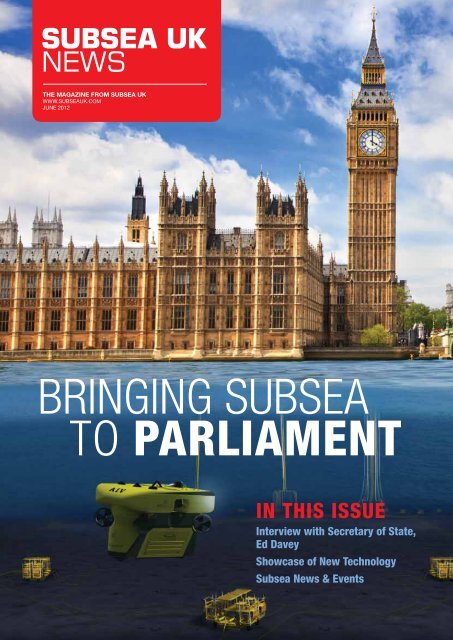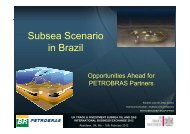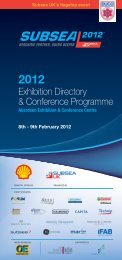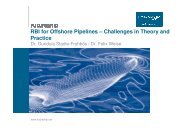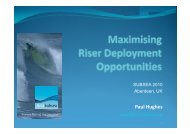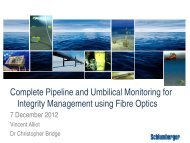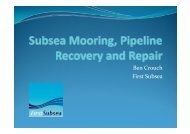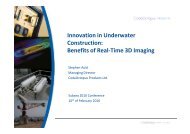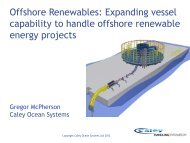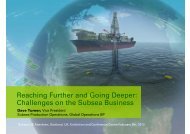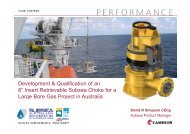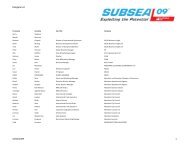BRINGING SUBSEA TO PARLIAMENT - Subsea UK
BRINGING SUBSEA TO PARLIAMENT - Subsea UK
BRINGING SUBSEA TO PARLIAMENT - Subsea UK
Create successful ePaper yourself
Turn your PDF publications into a flip-book with our unique Google optimized e-Paper software.
<strong>SUBSEA</strong> <strong>UK</strong><br />
NEWS<br />
THE MAGAZINE FROM <strong>SUBSEA</strong> <strong>UK</strong><br />
WWW.<strong>SUBSEA</strong><strong>UK</strong>.COM<br />
JUNE 2012<br />
<strong>BRINGING</strong> <strong>SUBSEA</strong><br />
<strong>TO</strong> <strong>PARLIAMENT</strong><br />
IN THIS ISSUE<br />
Interview with Secretary of State,<br />
Ed Davey<br />
Showcase of New Technology<br />
<strong>Subsea</strong> News & Events
FOREWORD<br />
<strong>BRINGING</strong> <strong>SUBSEA</strong><br />
<strong>TO</strong> <strong>PARLIAMENT</strong><br />
The global subsea market is predicted to double<br />
over the next five years and <strong>Subsea</strong> <strong>UK</strong> wants to<br />
ensure that the <strong>UK</strong> is best placed to capitalise on<br />
this opportunity.<br />
Our industry has unprecedented growth records and generates around £6<br />
billion per annum, which accounts for around a third of the global market<br />
share, and supports 50,000 jobs with the capability to generate more wealth<br />
and sustainable jobs across the <strong>UK</strong>.<br />
As the established seat of subsea learning and test-bed for R&D transfer of<br />
technology, we currently lead the way globally with our world-class skills and<br />
know-how increasingly in demand. But more importantly than ever, there<br />
is no room for complacency, particularly as new overseas regions develop<br />
their markets and attract inward investment for companies which have local<br />
content as well as developing their in-country R&D centres.<br />
In order to maintain our place as the world leaders in subsea expertise, we<br />
must continue our commitment to developing new technologies and support<br />
our industry in the <strong>UK</strong> as well as overseas.<br />
One of our priorities is to engage with government to ensure support is in<br />
place to drive forward technological developments and ensure the <strong>UK</strong> subsea<br />
sector remains at the cutting-edge of advancements across the world.<br />
Many <strong>UK</strong> companies still consider the risk outweighs the benefits of working<br />
in new markets and we are actively engaging with and supporting our<br />
members as they export their experience and technology into new frontiers.<br />
Continually facing a skills shortage is a challenge the <strong>UK</strong> supply chain has in<br />
keeping up with demand in manufacturing levels as well as meeting growth<br />
projections.<br />
Meaningful collaboration between industry and academia is essential in the<br />
drive to train and mentor qualified people, and this is why we have launched<br />
our MSc scholarship programme for a second year.<br />
<strong>Subsea</strong> <strong>UK</strong>’s skills programme has extended to hosting a range of events<br />
aimed at attracting talent from engineering students to highly-skilled<br />
ex-military professionals into the industry. We are also partnering on the<br />
development of an Inside Industries website aimed at engaging with<br />
school pupils.<br />
I believe building an understanding of the industry is vital in order to gain the<br />
support required from government and academia to continue growing and<br />
developing. Reaching out and informing a diverse range of audiences will<br />
help us retain our place as the global leaders in subsea expertise.<br />
I hope you enjoy our parliamentary special edition of <strong>Subsea</strong> <strong>UK</strong> News.<br />
New Members<br />
• 2H Offshore<br />
• Aberdeen College<br />
• ACE Winches<br />
• BAE Systems Australia<br />
• D-Comms (Scotland) Ltd<br />
• GAC Shipping (<strong>UK</strong>) Ltd<br />
• Glacier Energy Services<br />
• Intec (<strong>UK</strong>) Ltd<br />
• KB Associates (Europe)<br />
Limited<br />
• MetalTek International <strong>UK</strong><br />
Ltd<br />
• Neptune Oceanographics<br />
Ltd<br />
• Ocean Installer<br />
• Paull & Williamsons LLP<br />
• Pinsent Masons LLP<br />
• Salamanca Risk<br />
Management<br />
• Signal2Noise<br />
• Transvac<br />
• Unique Systems (<strong>UK</strong>) Ltd<br />
• Vulcan SFM<br />
To view the full <strong>Subsea</strong> <strong>UK</strong> members list, visit the <strong>Subsea</strong> <strong>UK</strong><br />
Directory at www.subseauk.com<br />
Forthcoming Events<br />
August 2012<br />
<strong>Subsea</strong> <strong>UK</strong> Challenge Cup -<br />
Golf Day, Inchmarlo<br />
17 August 2012<br />
Lunch and learn with<br />
CNR International<br />
AECC, Aberdeen<br />
21 August<br />
September 2012<br />
Rio Oil and Gas – pavilion<br />
in the Exhibition and<br />
networking events<br />
17 – 20 September<br />
October 2012<br />
<strong>Subsea</strong> Asia, Kuala Lumpur<br />
– Conference, Exhibition and<br />
networking events<br />
3 – 5 October<br />
November 2012<br />
<strong>Subsea</strong> <strong>UK</strong> at Sheffield<br />
University<br />
22 November 2012<br />
December 2012<br />
<strong>Subsea</strong> Pipeline Integrity<br />
Management Conference,<br />
London<br />
7 December 2012<br />
AGM and Christmas<br />
Networking Dinner,<br />
Aberdeen<br />
13 December 2012<br />
February 2013<br />
<strong>Subsea</strong> 2013, Conference,<br />
Exhibition and Business<br />
Awards Dinner – Aberdeen<br />
6 – 7 February 2013<br />
Neil Gordon<br />
Chief Executive, <strong>Subsea</strong> <strong>UK</strong><br />
November 2012<br />
<strong>Subsea</strong> South East Branch<br />
Meeting, London<br />
8 November 2012<br />
Australasia Oil & Gas 2013,<br />
Conference and Exhibition –<br />
Perth, Australia<br />
20 – 22 February 2013<br />
<strong>Subsea</strong> <strong>UK</strong> News | June 2012 3
BUSINESS<br />
North East Scotland: the Core of the<br />
<strong>UK</strong>’s <strong>Subsea</strong> Sector<br />
The North East of Scotland has long been recognised<br />
as the power house of Europe’s energy supply.<br />
With an estimated £1trillion of oil and gas still to be<br />
recovered and a growing marine renewables sector,<br />
prospects for the local economy remain encouraging.<br />
The region is home to almost 40% of the <strong>UK</strong>’s subsea industry<br />
which generates £6billion per year and the companies located<br />
in Westhill, Aberdeenshire, account for some 6,000 employees.<br />
With major players like Technip and <strong>Subsea</strong> 7<br />
alongside many home-grown, entrepreneurial<br />
engineering and technology firms like Tritech<br />
International, Forum <strong>Subsea</strong> Technologies and<br />
NCS Survey, Westhill possesses a significant critical<br />
mass of subsea excellence with global reach.<br />
Just a short drive from Westhill, Peterhead is fast becoming<br />
the subsea sector’s port of choice, providing exceptional<br />
all-weather, congestion-free deepwater berthing facilities with<br />
water depths alongside of up to 14 metres. Peterhead Port<br />
Authority has made significant investment in recent years,<br />
most notably at Smith Quay. Opened for business in October<br />
2010, the quay provides a 10 metre water depth, a 200-metre<br />
long berthing, together with a working area of 16,000 square<br />
metres. A lift capability of 500 tonnes is provided on the quay’s<br />
heavy lift pad, while modules of up to 2,500 tonnes can be skid<br />
loaded or discharged. The facility also offers a range of storage<br />
options for goods being uploaded or discharged from the port.<br />
WESTHILL BY NUMBERS<br />
From left to right: Sir Robert Smith MP, Neil Gordon, CEO <strong>Subsea</strong> <strong>UK</strong><br />
and Jill Webster, the Provost of Aberdeenshire<br />
With subsea vessels growing ever larger, fewer ports are able<br />
to accommodate them. Smith Quay can handle large quayside<br />
fabrication and assembly, mobilisation and vessel modification.<br />
Recent visiting vessels include Seven Atlantic (17,496 gross<br />
tonnes), Skandi Arctic (18,640gt) and Edda Fiddes (20,323gt).<br />
Less than 1.5km from the Port lie two significant employment<br />
land developments. The Energetica Industry Park is a<br />
22 hectare (55 acre) site is owned by Scottish Enterprise<br />
which is ear marked for development into an exemplar low<br />
carbon business park. With planning permission already<br />
in place, servicing will commence shortly which will permit<br />
sites to be available prior to the end of 2012. Further land is<br />
available at the established Dales Industrial Estate owned<br />
by Aberdeenshire Council. Plans are in place to service an<br />
additional 18.5 hectares (7.5 acres) of business land with<br />
availability from early 2013. The offering at Peterhead, linkages<br />
via the Port and plentiful available land at considerably lower<br />
costs when compared to other areas in Aberdeen City and<br />
Shire make Peterhead an increasingly attractive proposition<br />
to subsea operators.<br />
Peterhead, Aberdeenshire<br />
• NE Scotland’s premier<br />
subsea port<br />
• Heavy lift quay with<br />
10 metres water depth<br />
Westhill, Aberdeenshire<br />
• Number 1 global location for<br />
subsea engineering expertise<br />
• Excellent local amenities and<br />
services<br />
• Close to Cairngorms National<br />
Park and ski resorts<br />
• Adjacent to line of Aberdeen<br />
bypass<br />
• Aberdeenshire rated best for<br />
quality of life in rural Scotland<br />
40% of the <strong>UK</strong>’s<br />
<strong>Subsea</strong> industry<br />
Over 6,000<br />
employees<br />
• 16000 square metres of<br />
laydown / fabrication area<br />
• Excellent road access<br />
4 <strong>Subsea</strong> <strong>UK</strong> News | June 2012
BUSINESS<br />
Bibby Offshore Hosts Visit<br />
by Senior <strong>UK</strong> Minister<br />
Aberdeen-based subsea installation contractor Bibby Offshore recently hosted a visit by the Secretary of<br />
State for Scotland, Rt. Hon. Michael Moore MP, as part of a fact-finding mission on the energy sector in the<br />
city, in conjunction with Oil & Gas <strong>UK</strong>.<br />
He joined senior representatives from<br />
Bibby Offshore for a tour of Aberdeen<br />
harbour and heard how the company<br />
has successfully grown both in the <strong>UK</strong><br />
North Sea and internationally with plans<br />
for further expansion.<br />
Bibby Offshore Managing Director<br />
Fraser Moonie said: “We were delighted<br />
to have the opportunity to host the visit<br />
by a senior minister from the <strong>UK</strong> cabinet<br />
with influence over future energy policy.<br />
“Activity in the North Sea is strong<br />
and we expect it to continue to<br />
be so, while our international<br />
operations are also growing. As<br />
a result, we have continued our<br />
investment programme in vessels<br />
and the necessary recruitment<br />
in people to support the growth<br />
within the business.<br />
“We recruited approximately 75 new<br />
staff in Aberdeen last year and plan to<br />
add a further 70 this year thanks to our<br />
investment in new tonnage serving the<br />
North Sea market. We now have more<br />
than 200 onshore and 450 offshore staff<br />
based out of Aberdeen, Singapore and<br />
Trinidad. To accommodate the ongoing<br />
increase in staff numbers and services,<br />
we are moving to new purpose-built<br />
headquarters in the Aberdeen area in<br />
2013.’’<br />
The Minister also met graduates Katie<br />
Roberts and Charlie Jordan who<br />
joined Bibby Offshore as part of its<br />
Bibby Academy initiative to add to the<br />
talent within the business. It involves<br />
a graduate recruitment programme,<br />
attracting and retraining personnel from<br />
other industries via a skills conversion<br />
course and supporting ongoing staff<br />
training and development.<br />
Mr Moonie continued: “Our business<br />
is about people and one of our core<br />
values is to realise their talent and<br />
empower them to achieve. There are<br />
well-documented skills challenges<br />
facing our industry and we are working<br />
to overcome them through our Bibby<br />
Academy initiative and the skills<br />
conversion courses. Any support and<br />
initiatives available at both local and<br />
national government level would clearly<br />
be welcomed in order to help meet the<br />
employment demand.”<br />
The Secretary of State for Scotland,<br />
Michael Moore, said: “The oil and gas<br />
sector is of immense importance to<br />
our economy and it is important that<br />
we support a business environment<br />
which creates stability and investment<br />
confidence and leads to growth and<br />
jobs. The <strong>UK</strong> Government is working to<br />
support the industry and I was glad to<br />
hear about Bibby’s recent successes<br />
first hand in Aberdeen today.”<br />
Bowtech Products Supply HD Cameras for Prestigious & Challenging<br />
Pipeline Survey Project in Brazil<br />
Bowtech Products Ltd has announced that they have supplied an imaging system for the first pipeline survey ever to be<br />
carried out using High Definition (HD) cameras, for a major operator in Brazil.<br />
This high profile survey of 2,600km of pipelines, from a few metres<br />
depth to the deepest well in Brazil, was carried out by a major<br />
subsea player from their flagship survey vessel. This project is being<br />
watched closely by major oil and gas operators, who are interested<br />
to use HD cameras for future pipeline surveys.<br />
This project followed the <strong>Subsea</strong> 2011 exhibition, where Mike<br />
Winstanley, Sales Director at Bowtech, was introduced to a number of<br />
key officials from Petrobras, by the <strong>UK</strong> Trade & Investment (<strong>UK</strong>TI) team<br />
from Brazil.<br />
Mike then took part in a <strong>UK</strong> Trade & Investment (<strong>UK</strong>TI), Scottish<br />
Development International (SDI) and <strong>Subsea</strong> <strong>UK</strong> trade mission<br />
Rt. Hon. Michael Moore MP (left) and Bibby Offshore Managing Director Fraser Moonie (right)<br />
to Brazil, where he visited Petrobras in person. This was a highly<br />
successful meeting, which resulted in HD vision being specified for<br />
the survey and ultimately Bowtech winning the subsea vision system<br />
contract for the pipeline survey. This project, with others helped<br />
Bowtech being awarded the <strong>Subsea</strong> <strong>UK</strong> 2012 Global Export Award.<br />
Winning the 2012 Global Export Award demonstrates Bowtech’s<br />
ability to adapt in new markets and deliver project solutions to meet<br />
demanding underwater applications, through to completion. This is<br />
confirmed, as the same contractor has employed more HD vision<br />
systems, on contract in the North Sea.<br />
Oldham Engineering Ltd<br />
– Working with Government<br />
& Regional Authorities for<br />
Over 150 Years<br />
Today it is difficult to understand<br />
what life was like before the<br />
invention of the television in<br />
1925 or telephone in 1876.<br />
However, in 1861 at the end of the<br />
industrial revolution, a couple of<br />
entrepreneurs saw an opening<br />
to supply millwright work to the<br />
Oldham Corporation, a Regional<br />
Council at the time. Oldham<br />
Engineering Ltd was subsequently<br />
formed and celebrated its 150th<br />
anniversary last year.<br />
Today, Oldham Engineering Ltd is<br />
a premier supplier to the Nuclear,<br />
Offshore, <strong>Subsea</strong>, Defence and General<br />
Engineering sectors. With a culture of<br />
continuous improvement, an 80,000sqft<br />
facility and investment in the latest<br />
machine tool technology, the company<br />
excels in managing turnkey projects<br />
specifically with medium to heavy<br />
engineering content.<br />
Back in 1861, Oldham Engineering,<br />
previously named Buckley and Taylor,<br />
supplied Valves for the waterworks<br />
schemes and made a name for<br />
themselves in the 1860’s in the<br />
production of steam engines. Their<br />
founder, Mr. Buckley, became a member<br />
of the Oldham Council in 1876 in his<br />
pursuit to further help develop <strong>UK</strong><br />
industry.<br />
In the 1930’s, with the demise of engine<br />
manufacture, Oldham Engineering<br />
diversified into the marine industry,<br />
manufacturing marine auxiliary<br />
equipment, heat exchangers and<br />
distillation plants. Their equipment was<br />
used worldwide by foreign governments,<br />
companies, commercial ships, cruise<br />
liners and ships of the British Admiralty.<br />
Today, Oldham Engineering Ltd is able to<br />
fabricate, stress relieve, machine, blast,<br />
paint and assemble products all under<br />
the same roof, enabling a high level of<br />
quality control and project management<br />
to successfully deliver projects on time.<br />
Oldham Engineering has an extensive<br />
range of 2, 3 and 4 Axis CNC machine<br />
tools, for light, medium and heavy<br />
manufacture. Capabilities include;<br />
• Floor Boring with 13m (42.7 feet)<br />
bed capacity<br />
• Vertical lathes to machine up to<br />
Ø2.1m (Ø6.9 ft)<br />
• 30 tonnes capacity Rotary Tables<br />
(5 axis)<br />
• Horizontal machining with 10m<br />
(32.8 feet) bed<br />
The company manufacture many<br />
components for the <strong>Subsea</strong> industry<br />
including; Female and Male Ball<br />
grabbers, Anchors and Rudders<br />
amongst others.<br />
BUSINESS<br />
In Spring 2012, Oldham<br />
Engineering obtained grant<br />
support from Manchester Council<br />
to allow the company to invest<br />
in a new 4 axis Soraluce floor<br />
boring machining centre, capable<br />
of machining components up to<br />
10m long and over 3m high in a<br />
single operation.<br />
This latest machine tool development is<br />
part of a significant capital investment<br />
program over the next 12 months, which<br />
will help to ensure Oldham Engineering<br />
maintains its leading premier position<br />
in the <strong>UK</strong> engineering sector and<br />
continues to service present and future<br />
Governments, Regional Authorities and<br />
associated partners.<br />
Images from left to right: Machining a Split Centrifugal Pump Casing,<br />
Machining a Male Ball Grabber and Oldham Engineering’s new Soraluce Machining Centre<br />
Steam Engine<br />
built by Oldham<br />
Engineering in 1883<br />
6 <strong>Subsea</strong> <strong>UK</strong> News | June 2012<br />
<strong>Subsea</strong> <strong>UK</strong> News | June 2012 7
BUSINESS<br />
BUSINESS<br />
Wood Group Kenny<br />
to Design the<br />
World’s First<br />
Combination of<br />
Wind and Wave<br />
Energy Producing<br />
Technologies<br />
Wood Group Kenny has been awarded<br />
a three-year contract by Marine<br />
Power Technologies Pty Ltd (MPT)<br />
to provide project management and<br />
engineering support services for the<br />
development of MPT’s Energy Island<br />
(EI) concept on the southern coastline<br />
of Australia.<br />
Six or more Energy Islands may be linked<br />
together to create an Energy Farm, which<br />
is estimated to supply power to 16,500<br />
Australian households per year.<br />
The triangular shaped EI will comprise of<br />
six oscillating water column (OWC) wave<br />
energy devices and an offshore wind turbine<br />
assembly, and will be capable of generating<br />
up to 10 megawatts of power.<br />
Wood Group Kenny’s initial eight month<br />
scope of work under the contract will be<br />
carried out in two parts. The first part will<br />
involve a data gathering exercise covering a<br />
wide range of environmental and technical<br />
issues, and the second part will involve<br />
conceptual study work to define the layout<br />
and configuration of the overall EI assembly.<br />
Subsequent phases of Wood Group Kenny’s<br />
involvement in this project will focus on<br />
identifying opportunities for installing EI<br />
farms along Australia’s southern coastline,<br />
where there are significant wind and wave<br />
energy resources.<br />
Steve Wayman, CEO of Wood<br />
Group Kenny said: “This contract<br />
award strengthens Wood Group’s<br />
commitment to diversifying its longterm<br />
oil and gas expertise into the<br />
emerging global renewable energy<br />
market.”<br />
Tom Engelsman, CEO and Chairman of<br />
Marine Power Technologies said: “The<br />
Founders, Directors and Board of MPT<br />
have been thoroughly impressed with Wood<br />
Group Kenny’s work to date, and look<br />
forward to bringing the Energy Island to<br />
market with their team.”<br />
Ashtead Technology<br />
Partners with<br />
The Oceanscience Group<br />
World leading marine rental company, Ashtead Technology (Offshore<br />
Division) announces an exclusive agreement with The Oceanscience<br />
Group, to offer the UnderwayCTD and UnderwaySV systems for the<br />
rental market. For the first time, the revolutionary profiler is available<br />
for short or long term hire with systems supplied out of Ashtead<br />
Technology’s three regional bases - Houston, Aberdeen, and Singapore.<br />
This agreement is exclusive within the Oil and Gas industry.<br />
The UnderwayCTD/SV is a free fall<br />
profiling system that offers research<br />
quality conductivity, temperature, depth<br />
(CTD) or sound velocity (SV) profiles from<br />
a vessel moving at up to 14kts. Profiles<br />
over 1,000m are achievable at 4-5kts and<br />
with a turnaround time of only about 30<br />
minutes for a full depth cast, there is no<br />
faster way to gather affordable and high<br />
quality data.<br />
Mark Derry, Ashtead Technology Offshore<br />
Division Managing Director commented:<br />
“Ashtead Technology endeavours to<br />
meet our customers’ demands for the<br />
very latest subsea equipment. This<br />
agreement with The Oceanscience Group<br />
The UnderwayCTD system<br />
for the rental of their innovative profilers<br />
will provide our global hydrographic<br />
customers with the latest technology<br />
available, where and when they require it,<br />
on a flexible rental basis.”<br />
For hydrographic survey<br />
projects the exceptionally simple<br />
installation process and minimal<br />
infrastructure requirements make the<br />
UnderwayCTD/SV an ideal profiling<br />
system.<br />
Rental systems are now available.<br />
Nautronix Wins First Major<br />
Contract in Norway<br />
Nautronix have been awarded a three year contract by the Norwegian SURF contractor, Ocean Installer AS,<br />
for the supply of survey services, in addition to their opening of a new office in Norway.<br />
The contract includes the provision of<br />
onshore and offshore survey services<br />
in support of tendering and project<br />
activities. Nautronix will initially mobilise<br />
survey personnel and equipment onto the<br />
Normand Clipper. Ocean Installer’s long<br />
term chartered construction vessel has<br />
recently commenced offshore operations.<br />
Mark Patterson, Nautronix CEO,<br />
comments: “We are delighted to be<br />
awarded our first major contract in<br />
Norway by Ocean Installer, and are<br />
excited to be working closely with the<br />
ambitious Ocean Installer team. This<br />
will be a very important and rewarding<br />
relationship for Nautronix. It emphasises<br />
the expansion of Nautronix to provide<br />
a new level of service and supply and<br />
reflects our strategy to grow our business<br />
in the Norwegian market.”<br />
Mr. Patterson adds: “We have seen<br />
some very encouraging prospects for our<br />
NASNet ® and NASCoM product lines,<br />
this agreement will allow us to build on<br />
an already very strong team and help<br />
drive and grow our business into this very<br />
important market sector.”<br />
Sam Hanton, Nautronix Chief Surveyor,<br />
said: “The award of this contract by<br />
Ocean Installer is significant to Nautronix,<br />
and reflects our commitment to provide<br />
a high quality survey service. Both<br />
companies have ambitious growth<br />
aspirations and we are currently recruiting<br />
a number of people to join our team in<br />
support of this activity.”<br />
Ocean Installer AS was founded in early<br />
2011 and is headquartered in Stavanger,<br />
Norway.<br />
Nautronix are also celebrating<br />
the opening of a new office in<br />
Norway, which is located at Nedre<br />
Strandgate 27 in Stavanger, and<br />
are also delighted to announce the<br />
appointment of Jørn Berg as Vice<br />
President of Sales for Norway.<br />
CEO Mark Patterson adds: “With the<br />
heightened activity in Norway and having<br />
well established offices in Houston and<br />
Rio de Janeiro it made great sense to<br />
expand the company further and open a<br />
Nautronix entity in Norway.”<br />
Below: Nautronix’s new office in Norway<br />
8 <strong>Subsea</strong> <strong>UK</strong> News | June 2012<br />
<strong>Subsea</strong> <strong>UK</strong> News | June 2012 9
PROJECTS<br />
Prospect Submerge<br />
Themselves into a<br />
Challenging Project<br />
Prospect, a Superior Energy<br />
Services company, recently<br />
completed the detailed design of<br />
a submerged buoyancy collector<br />
(SBC) for Swire Seabed AS. The<br />
project was a response to an<br />
unplanned situation where over<br />
130 buoyancy modules required<br />
urgent removal from damaged<br />
flexible risers.<br />
The SBC was designed in two parts:<br />
a base and a collection cage. Once<br />
deployed to the seabed an ROV<br />
removed the locking pins allowing the<br />
collection cage to be raised off the<br />
base. The cage was then positioned<br />
above the pipeline where the buoyancy<br />
modules were tied down and the module<br />
straps were cut allowing them to float<br />
up into the cage. This procedure was<br />
repeated until the collector cage was<br />
full, where it was reattached to the base,<br />
so that it could be lifted onto a vessel<br />
for unloading. Prospect developed a<br />
working structure within an aggressive<br />
schedule initially using AutoCad Inventor<br />
to scale and detail the concept. The<br />
structure was analysed and optimised<br />
using structural analysis software, with<br />
complex regions validated using finite<br />
element analysis. Prospect provided the<br />
client with marine dynamic operational<br />
analysis of the SBC, confirming the<br />
stability and buoyancy of it both when<br />
fully laden and when empty.<br />
SBC being raised from the water<br />
Roger Tindley, Project Manager at Swire<br />
Seabed AS, said: “We had an idea of<br />
how to deal with the buoyancy elements<br />
on the risers, but needed an engineering<br />
analysis of its feasibility. Prospect<br />
carried the initial idea from design<br />
through to manufacture within a tight<br />
schedule and maintained close contact<br />
with ourselves and the constructors. We<br />
had complete confidence in operating<br />
the device and it performed completely<br />
within specifications.<br />
“This is the first time that an<br />
operation like this has been<br />
performed, and will undoubtedly<br />
have an impact on future<br />
decommissioning projects.”<br />
Ewan Giles, Prospect’s <strong>UK</strong> Sales &<br />
Marketing Manager, also added: “Swire<br />
Seabed AS are a fantastic client to work<br />
with who allowed us to get fully involved<br />
in the project. Undertaking a larger, off<br />
the wall design project has allowed us<br />
to work closely together to develop a<br />
bespoke solution that fits the client’s<br />
requirements perfectly.”<br />
MARS Lands<br />
Major Award<br />
The <strong>UK</strong>’s National Oceanography<br />
Centre (NOC)-based facility for<br />
Autonomous Underwater Vehicles<br />
(AUVs) and robotics has received a<br />
major government cash injection.<br />
The newly launched Marine Autonomous<br />
& Robotic Systems (MARS) facility, which<br />
went live on 1st April, has been awarded<br />
£2.85 million by the Department for<br />
Business, Innovation and Skills (BIS). The<br />
Isis remotely operated vehicle, currently<br />
undergoing a rebuild, will also benefit.<br />
Headed by Professor Gwyn Griffiths,<br />
NOC’s Chief Technologist, MARS<br />
provides technology and expertise to the<br />
wider marine science community.<br />
Around £2 million of the new capital<br />
will be invested in AUVs and gliders: it<br />
will fund two new Autosub Long Range<br />
vehicles and enable upgrades to NOC’s<br />
fleet of Slocum gliders, some of which<br />
are six years old, and will provide for<br />
two autonomous surface vehicles for the<br />
community.<br />
Staff at the NOC in Southampton have<br />
been able to see the new Autosub Long<br />
Range being put through its paces in a<br />
series of trials off Empress Dock recently.<br />
The remaining £800,000 will be used on<br />
new and replacement equipment for Isis.<br />
Gwyn said: “This capital injection,<br />
secured by the Natural Environment<br />
Research Council, is a strong vote of<br />
confidence by BIS in robotics as a new<br />
paradigm for ocean data-gathering, as a<br />
spur to innovation and growth, and in the<br />
ability of NOC to provide leading edge<br />
capability in this area.”<br />
The creation of MARS has seen NOC’s<br />
world-leading expertise in Autosubs and<br />
gliders consolidated at the Southampton<br />
Waterfront Campus.<br />
<strong>Subsea</strong> <strong>UK</strong> News | June 2012 11
PROJECTS<br />
GROWTH<br />
Transvac Completes Test<br />
Program for FMC Technologies<br />
Ejector solutions provider, Transvac, recently completed a comprehensive test program for FMC Technologies,<br />
for pressure boosting and flushing ejectors (<strong>Subsea</strong> Jet Pumps) for Petrobras’ Marlim subsea separation project.<br />
This was not the first time FMC had<br />
turned to Transvac for a custom designed<br />
ejector solution. The relationship began<br />
with the highly successful <strong>TO</strong>RDIS<br />
project – the world’s first full-field subsea<br />
separation system with boosting and<br />
injection, for which Transvac supplied a<br />
super duplex ejector.<br />
Transvac subsea ejectors for Marlim<br />
include special ceramic wear-resistant<br />
internals and underwent full flow<br />
performance mapping using Transvac’s<br />
R&D facility flow loop system.<br />
The Marlim project consists of a subsea<br />
separation system designed to separate<br />
water from oil, gas and sediments and reinjects<br />
the separated water into the water<br />
reservoir. The oil, gas and sediments are<br />
then routed to the host platform topside.<br />
The separation system is now installed in<br />
Marlim field, which is located in Campos<br />
Basin, at a water depth of 870m.<br />
“The past year has been very<br />
exciting for us, and we look<br />
forward to bringing our 40 years’<br />
experience, technology and<br />
innovation to the fore,” says<br />
David Ainge, sales and marketing<br />
director.<br />
“The advantages of this technology –<br />
no moving parts, no maintenance, no<br />
running costs etc. – sells itself. Now,<br />
with the opening of our R&D test facility<br />
last year, we can offer a whole new level<br />
of product assurance to our clients. We<br />
can prove our technology, the clients<br />
can come and witness tests and we can<br />
offer performance mapping for peace of<br />
mind going forward.”<br />
Main Image: Marlim subsea separation<br />
module, home to Transvac’s sand slurry<br />
pumping Ejector.<br />
Inset: CFD modelling carried out at the<br />
Transvac R&D Test Facility<br />
Success for <strong>Subsea</strong> Specialist’s<br />
Newcastle Operation<br />
Andy Lake and Flexlife’s Chief Operating Officer<br />
John Marsden celebrate a successful first six<br />
months in Newcastle<br />
NCS Survey Completes Bathymetric Survey of Rubislaw Quarry<br />
NCS Survey, an Acteon company, has recently completed a bathymetric survey of<br />
Rubislaw Quarry to aid decision making for the redevelopment of the site. For 200 years,<br />
Rubislaw Quarry, which is in the west of the City of Aberdeen, supplied 6 million tonnes of<br />
granite to prestigious construction projects worldwide, including the footings for the Forth<br />
Rail Bridge and for Waterloo Bridge in London. The quarry closed in 1971 and has since<br />
filled with water to a depth of 152m.<br />
The survey involved acquiring and processing multibeam<br />
echo sounder data to produce a 3D digital<br />
terrain model of the flooded quarry to determine<br />
the water depth and identify any objects on the<br />
quarry bed for further investigation using a remotely<br />
operated vehicle (ROV). The data will also aid<br />
volumetric calculations to determine the amount of<br />
water involved if the owners decide to partially drain<br />
the quarry, as the rising water level is a potential<br />
threat to neighbouring homes and businesses.<br />
The survey equipment was provided by NCS<br />
Survey and Seatronics, another member of the<br />
Acteon group of companies, which also provided<br />
the eyeball ROV used for investigating the sonar<br />
contacts on the second day of the survey.<br />
A crane lifted the lightweight offshore support<br />
vessel used for the survey in and out of the quarry<br />
between nearby blocks of flats.<br />
The survey was successful but the anticipated<br />
abandoned machinery was not found: the only<br />
submerged objects identified by the sonar survey<br />
were found to be trees when inspected using the<br />
ROV.<br />
Plan display showing lower AOI<br />
Flexlife, an oil and gas industry specialist in subsea project and integrity management, has seen great<br />
success at its Newcastle base just six months after opening.<br />
The company has taken on 20 members<br />
of staff including engineers, planners,<br />
designers, quality assurance and<br />
contract specialists at its Baltic Place<br />
offices. This number is expected to<br />
double in the coming 12 months due<br />
to increasing demand for the wide<br />
range of subsea project and integrity<br />
management services being offered.<br />
Andrew Lake, Director of Operations<br />
in Newcastle, said: “It has been an<br />
unbelievable six months with work being<br />
completed for major clients in key oil<br />
and gas regions around the globe<br />
and the business unit already making<br />
a profit.<br />
“The team has undertaken a number<br />
of diverse projects including a flexible<br />
pipe project in the Irish Sea, managing<br />
a pipeline investigation in South Africa<br />
and a range of asset/pipe integrity<br />
management projects in locations<br />
including the US, Norway, Angola<br />
and Ghana.”<br />
Chief Operating Officer John Marsden<br />
said: “The Newcastle base has been<br />
vital in supporting Flexlife’s global<br />
operation and will be a key element<br />
in the company’s continuing growth<br />
strategy.<br />
“The team has given a great deal<br />
of assistance to the US base on<br />
an on-going project and is also<br />
working on the research and<br />
development of new products<br />
to complement Flexlife’s suite<br />
of asset integrity management<br />
technology.<br />
“The office was set up in part to help<br />
expand our range of services to include<br />
front end engineering design (FEED).<br />
Work on various elements of this is<br />
currently underway based on the<br />
requirements and expectations of both<br />
current and prospective clients.”<br />
Flexlife’s global HQ is in Aberdeen,<br />
Scotland. The company also operates<br />
in the US, Africa, the Far East and<br />
Mediterranean. It was Scotland’s fastestgrowing<br />
young company in 2010.<br />
12 <strong>Subsea</strong> <strong>UK</strong> News | June 2012<br />
<strong>Subsea</strong> <strong>UK</strong> News | June 2012 13
FEATURE ARTICLE<br />
Ed Davey<br />
An Interview with<br />
Secretary of State, Ed Davey<br />
Department of Energy and Climate Change<br />
Does the Government appreciate the<br />
scale and significance of the subsea<br />
industry in the <strong>UK</strong>?<br />
Absolutely. This is an industry that’s<br />
grown by 40% in the past three years,<br />
and supports 50,000 jobs. Numbers<br />
like that are hard to ignore – especially<br />
when you think about the potential for<br />
future growth. As we move towards<br />
a more sustainable economy, our<br />
subsea industry will become even more<br />
important; not just for recovering our<br />
existing oil and gas reserves, but also for<br />
bringing on the next generation of marine<br />
renewables, electricity interconnectors,<br />
and carbon capture and storage.<br />
For the subsea industry to continue<br />
to lead the world and capitalise on<br />
the global opportunities, it needs to<br />
attract and develop skilled people.<br />
How could the Government support<br />
the industry in its quest to meet the<br />
skills shortages?<br />
In any industry, getting the right people<br />
in place now – and encouraging<br />
professional development in the future<br />
– is critical. We’re fortunate that we<br />
can draw on pretty deep reserves of<br />
expertise that already exist in the sector,<br />
but attracting new talent in a growing<br />
and competitive global market is always<br />
going to be challenging. Partly this is<br />
about visibility and preparedness: we<br />
need young people who are aware<br />
of the career options open to them,<br />
and ready to take advantage of them.<br />
Lots of organisations have a stake<br />
here: industry, educational bodies, and<br />
government all have a part to play.<br />
This sector is driven by technology<br />
development, and we’re working with<br />
Opito, Cogent, <strong>Subsea</strong> <strong>UK</strong> and with the<br />
Department for Business, Innovation and<br />
Skills to find better ways of getting the<br />
smartest people into the industry.<br />
“This is an industry that’s<br />
grown by 40% in the past<br />
three years, and supports<br />
50,000 jobs.”<br />
Both the <strong>UK</strong> and Scottish<br />
Governments are viewing the oil and<br />
gas industry much more positively<br />
with strategies which encourage<br />
investment, enhanced recovery,<br />
innovation, technology and skills<br />
developments. Innovation and the<br />
development of new technology<br />
have been key to the success of<br />
the industry to date but support is<br />
required in research, development and<br />
commercialisation of the next wave of<br />
new technologies. How do you think<br />
the industry could secure assistance<br />
from Government in this area?<br />
Innovation and technology development<br />
are central to our future energy security.<br />
We’ve got all the right ingredients for<br />
success: a vibrant entrepreneurial<br />
industry, a world-leading scientific and<br />
research base, and clear policy signals<br />
from government. There’s a reason that<br />
some of the most promising new energy<br />
technologies – from Wave Hub in the<br />
South West to Pelamis in Scotland –<br />
have emerged here in the <strong>UK</strong>. But we<br />
need the kind of dynamic economy<br />
where good ideas can jump from the<br />
drawing board to the boardroom;<br />
where companies spun-out from<br />
universities can capture the benefits of<br />
new research, turning our scientific and<br />
engineering excellence into jobs and<br />
growth. That won’t happen overnight,<br />
but we’ve got a range of policies to help<br />
– from the Technology Strategy Board<br />
to our £1 billion competition for the first<br />
commercial demonstration of carbon<br />
capture and storage. We’re also looking<br />
at the barriers to innovation; PILOT, the<br />
<strong>UK</strong> oil and gas taskforce, is working<br />
to bring greater clarity to the R & D tax<br />
credit scheme to ensure industry is<br />
taking up the offer, and will be presenting<br />
the sector’s technology challenges to<br />
developers and innovative companies at<br />
an event later this year.<br />
How do you think the industry could be<br />
engaging more with Government?<br />
We work closely with the industry<br />
through PILOT, and through regular Trade<br />
Association meetings chaired by my<br />
colleague Charles Hendry. There are real<br />
opportunities for the industry to make<br />
its voice heard: particularly in the PILOT<br />
workgroups, which were set up to deal<br />
with the most pressing challenges like<br />
improved recovery, infrastructure issues<br />
and the supply chain. And of course<br />
there’s a steady stream of consultations<br />
to respond to!<br />
With the new Energy Bill, the<br />
Government has underlined its<br />
support for a balanced energy<br />
strategy which is shared by <strong>Subsea</strong><br />
<strong>UK</strong>. The subsea industry is wellpositioned<br />
to support the current<br />
oil and gas industry, enhanced oil<br />
recovery including carbon capture<br />
and storage as well as marine<br />
renewables. The engineering expertise<br />
of our industry can place the <strong>UK</strong> at<br />
the forefront in these areas. Is the<br />
Government able to help us ensure<br />
this message is communicated across<br />
all energy sectors and to help us<br />
engage with the renewable sector<br />
more meaningfully?<br />
“There are real opportunities for the industry to make<br />
its voice heard: particularly in the PILOT workgroups,<br />
which were set up to deal with the most pressing<br />
challenges like improved recovery, infrastructure<br />
issues and the supply chain.”<br />
As new energy technologies come<br />
onstream, we want to make sure as<br />
much of the value – and the supply<br />
chain – stays here in the <strong>UK</strong>. We’re<br />
fortunate to have such a strong range<br />
of companies in the subsea sector, with<br />
world-leading expertise right across the<br />
energy portfolio. The challenge now is<br />
to harness that expertise to the new<br />
energy technologies that are of global<br />
importance; and the best way to put our<br />
industry first is to demonstrate success.<br />
There are real opportunities for joint<br />
working: we’re the world’s most attractive<br />
place to invest in offshore wind, we’ve<br />
got significant programmes to bring on<br />
marine energy and CCS, and we’ve got a<br />
subsea sector that has the capacity and<br />
the experience to deliver big projects.<br />
Linking these different parts of our energy<br />
economy will take time and effort on all<br />
sides; we can develop standards, set<br />
the strategic direction, and bring people<br />
together, but there are some things that<br />
the market can do much more efficiently<br />
than government. That said, DECC<br />
Ministers and officials are always vocal<br />
in support of our energy industries – and<br />
when we talk to developers, investors,<br />
and generators, you can rest assured<br />
we’ll be banging the drum for Britain’s<br />
subsea sector.
TECHNOLOGY<br />
TECHNOLOGY<br />
Tritech’s Gemini SeaTec Sonar<br />
Offers Enhanced Mammal Detection<br />
Gemini<br />
SeaTec Sonar<br />
Gemini SeaTec provides an early warning of the presence of marine<br />
mammals in the vicinity of marine current turbine structures. The Gemini<br />
SeaTec system has been successfully field tested on the Marine Current<br />
Turbine (MCT) SeaGen installation in Strangford Lough, Northern Ireland,<br />
overseen and tested by the Sea Mammal Research Unit (SMRU) Ltd.<br />
Launched at last year’s All-Energy<br />
exhibition in Aberdeen, Scotland, the<br />
latest version of Gemini SeaTec system<br />
includes improved software algorithms<br />
for analysing moving marine life<br />
targets according to their size, shape<br />
and swimming behaviour. Targets are<br />
categorised using a traffic light system,<br />
indicating the probability that a moving<br />
target is a marine mammal.<br />
‘Possible’ (green) targets are the correct<br />
size and shape; ‘Potential‘(amber)<br />
denotes upgraded ‘Possible’ targets that<br />
also have a path that suggests the object<br />
is not moving with tidal drift. ‘Probable’<br />
(red) targets are upgraded from ‘Potential’<br />
when they have a high probability of<br />
being a marine mammal. Using this<br />
scheme also allows the software to<br />
eliminate a large number of false targets<br />
such as marine debris moving passively<br />
with the tide and fish that are both too<br />
small and identified as part of a group.<br />
A visual proximity alarm can be set to<br />
alert a human observer to the presence<br />
of a target that has a high probability of<br />
being a marine mammal. This can aid in<br />
precautionary shutdown decisions,<br />
where necessary.<br />
Reports can also be generated that<br />
reference presumed ‘marine mammals’<br />
and display their path history and<br />
classification status at each step.<br />
These reports are cross referenced with<br />
Gemini SeaTec software showing visible moving<br />
targets as red alerts: denoting the probability of<br />
targets being marine mammals. Here the targets<br />
were seals.<br />
visual log data for effective post-hoc<br />
analysis and can be used for analysing<br />
marine mammal behaviour as part of<br />
environmental impact assessments.<br />
Gordon Hastie from SMRU Ltd,<br />
comments: “The development of<br />
the Tritech Gemini has allowed us to<br />
effectively measure the close range<br />
interactions between marine mammals<br />
and tidal turbines in a far more efficient<br />
way than was previously possible.”<br />
Viewtooth ® : The Next Generation<br />
of <strong>Subsea</strong> Cameras<br />
For many offshore applications, a camera for visual inspection and support can significantly improve reliability<br />
and efficiency of operations. Use of a wireless subsea camera can remove the need for additional underwater<br />
vehicles by providing multiple perspectives, reducing cost and deployment time and increasing reliability and<br />
deployment possibilities for cameras across industries such as: offshore, survey, decommissioning, scientific<br />
research, diving and security.<br />
Viewtooth ® is the next generation<br />
of subsea camera. It uses WFS<br />
Technologies patented seatooth ®<br />
technology to stream images from<br />
under the sea, wirelessly. Elimination of<br />
cabling renders the subsea camera more<br />
robust in the deep water conditions,<br />
supporting applications from offshore<br />
troubleshooting to monitoring of subsea<br />
installations removing the cost of<br />
deploying multiple underwater vehicles.<br />
The camera can stream live video back<br />
to a data collection point (another<br />
ROV or hardwired receiver) and can be<br />
deployed by ROV. The unit can achieve<br />
a wireless range of up to 5m in high<br />
temperatures and can be easily and<br />
simply mounted on an ROV/AUV, or<br />
other structure for immediate operation.<br />
Ease of deployment makes the camera<br />
suitable for temporary operation as well<br />
as permanent installation. Capable of<br />
operating in depths from 100m-4,000m,<br />
Viewtooth ® is still light enough to attach<br />
to a small intervention ROV to undertake<br />
a wide range of inspection tasks in deep<br />
water and transmit critical visual data<br />
wirelessly.<br />
The unit can be recharged in situ if<br />
required for longer deployments and<br />
can support standard connections with<br />
remote underwater vehicles. Viewtooth ®<br />
is available in a shallow water (up to<br />
350m) enclosure, and also a robust<br />
316 stainless steel, chemical resistant,<br />
4,000m housing, rugged enough to<br />
withstand deep water conditions.<br />
Viewtooth ® is also a non-specific<br />
housing, allowing a range of subsea<br />
camera modules to be used, depending<br />
on the requirements of the project and is<br />
compact and portable, easily operated,<br />
and can be set up and operational in a<br />
short space of time.<br />
Images selected from recent <strong>UK</strong> demonstrations of<br />
Viewtooth ® at Fort William<br />
<strong>Subsea</strong> <strong>UK</strong> News | June 2012 17
TECHNOLOGY<br />
Top: BPP-RMS main display (customisable)<br />
Above: Drilling riser top tensioning and flex<br />
arrangements<br />
Left: BOP another very important aspect of safety<br />
along with BPP-RMS<br />
BPP-TECH Supplies Drilling Riser Variant<br />
BPP-TECH have recently supplied drilling riser variant ‘Riser<br />
Management Systems’ (BPP-RMS) to Converteam (GE Power<br />
Conversion). The BPP-RMS was installed at the DSME shipyard in Korea.<br />
The contract covers three ultra-deepwater vessels. It will be supplied to<br />
Odebrecht in Brazil Norbe VIII and IX, and the Vantage Tungsten Explorer.<br />
Marine risers for production, drilling, or<br />
intervention are increasingly monitored<br />
to assess their health and to predict their<br />
remaining lives. With the tremendous<br />
increases in modern day computing<br />
power, it is possible to make highly<br />
sophisticated real-time use of the data<br />
from a wide range of highly reliable<br />
instrumentation.<br />
Significant issues include improved<br />
reliability with difficult to predict<br />
behaviour e.g. vortex induced vibrations<br />
(VIV); enabling operations in uncertain<br />
environments e.g. sheared, loop,<br />
and eddy currents; monitoring during<br />
installation and operations; fatigue<br />
tracking and management of joints; and<br />
transit performance of suspended risers.<br />
BPP-TECH continues to develop<br />
advanced sensing and data handling<br />
for improved real-time operational<br />
optimisation, leading to improved safety<br />
and cost-effectiveness. An example is the<br />
Riser Management System (BPP-RMS)<br />
which has application for flexible risers,<br />
SCRs, as well as top-tensioned risers.<br />
Riser Management System<br />
In the drilling riser variant, BPP-RMS<br />
provides on-board optimum position<br />
advice for the MODU, limiting the<br />
flex-joint angles and wellhead loads<br />
within pre-set limits. This ensures less<br />
wear of the riser and helps the operator<br />
to maximise the time available for<br />
emergency disconnect operations.<br />
Without BPP-RMS: a sub-optimum<br />
approach must be adopted, by relying<br />
entirely on the results of analyses<br />
conducted prior to carrying out drilling<br />
operations to over-conservatively<br />
determine safe operation of a riser. A<br />
necessarily limited range of ‘predicted<br />
combined environmental conditions’<br />
with the assumed ‘vessel and riser<br />
configuration’, are used to establish the<br />
safe operating envelopes for a specified<br />
riser tension. The limits are determined by<br />
undesirable stresses, bending moments,<br />
and deflections of the riser. Since the<br />
actual conditions will differ, this approach<br />
results in over-cautious limits.<br />
BPP-TECH anticipate that Riser<br />
Management Systems will in the<br />
future become mandated by the<br />
regulatory authorities to improve<br />
safety for drilling operations,<br />
particularly in the light of the<br />
recent Deepwater Horizon<br />
Macondo incident.<br />
<strong>Subsea</strong> <strong>UK</strong> News | June 2012 19
TECHNOLOGY<br />
The new Marin Debris Removal System grab,<br />
with a mobilised capacity of 100 tonnes,<br />
dwarfs two Marin Group vehicles.<br />
TECHNOLOGY<br />
New Marin Grab Takes Debris Recovery<br />
to Full Ocean Depth<br />
Marin <strong>Subsea</strong> has unveiled its versatile new subsea recovery grab tool designed for use across a range of<br />
subsea applications, including large-scale brownfield clearance.<br />
The tool forms part of the Marin Debris<br />
Recovery System (MDRS) and is the first<br />
proprietary technology high-volume grab<br />
capable of operating in harsh deepwater<br />
environments to full ocean depth for the<br />
recovery of assorted debris.<br />
With a mobilised capacity of 100 tonnes,<br />
the MDRS grab can be single-wire<br />
deployed or by a remote actuation<br />
pack and operated via clients’ ROV<br />
intervention systems.<br />
The grab is the latest in a series of<br />
complementary proprietary tools brought<br />
to market by Marin Group – of which<br />
Marin <strong>Subsea</strong> is an operating company<br />
– to deliver a one-stop debris recovery<br />
service.<br />
Sonardyne Showcases Innovation<br />
and Design at Marine Industry Event<br />
20 <strong>Subsea</strong> <strong>UK</strong> News | June 2012<br />
Group CEO George Stroud said: “This<br />
grab is unlike anything currently available<br />
and is of particular interest to clients in<br />
the decommissioning, renewables and<br />
route preparation sectors.<br />
“It is extremely versatile, can be used<br />
at any depth, and can be configured<br />
to address a wide variety of subsea<br />
requirements, either as a standalone tool<br />
or in conjunction with our Evo JetProp<br />
high-volume excavation systems and Evo<br />
Shearpower cutting tool.”<br />
The MDRS grab (patent pending) can<br />
be configured for applications including<br />
the recovery and removal of rock dump,<br />
mixed debris, concrete mattresses,<br />
protection covers, pipelines and cables.<br />
April 2012 saw the first ever marine industries showcase held<br />
at the department for Business Innovation and Skills (BIS) in<br />
London. Held in association with the <strong>UK</strong> Marine Alliance, ‘Marine<br />
Manufacturing – Global excellence and innovation’ celebrated<br />
the role of the <strong>UK</strong> manufacturing across five key themes:<br />
leisure, naval, marine energy, commercial and marine science.<br />
Business Minister Mark Prisk enjoyed a tour of the showcase,<br />
meeting with business leaders and exploring some of the latest<br />
developments in marine technology, design and innovation.<br />
Exhibiting as a multi-divisional marine<br />
engineering and science business, Sonardyne<br />
International Ltd was on hand to discuss the<br />
increasing popularity of its maritime security<br />
and offshore survey technologies. Alongside<br />
its intruder detection sonar technology,<br />
Sentinel, Sonardyne’s Strategic Development<br />
and Marketing Director Rob Balloch presented<br />
the latest developments to the company’s<br />
sixth generation (6G ® ) subsea positioning<br />
product line up.<br />
6G products use Sonardyne’s ultra-wideband<br />
width, digital ranging and telemetry protocols<br />
Mr Stroud added: “Although we<br />
envisage the MDRS being primarily<br />
used within the energy industry, it<br />
can also be configured for other<br />
maritime jobs such as light aircraft<br />
and helicopter recovery.”<br />
<strong>Subsea</strong> <strong>UK</strong> member Marin <strong>Subsea</strong> is the<br />
founding member of the Marin Group,<br />
which is based in Ellon, near Aberdeen,<br />
with further bases in Asia Pacific, the Gulf<br />
of Mexico, Central and South America,<br />
and is underpinned by 30 years at the<br />
cutting edge of subsea excavation<br />
design, build and delivery.<br />
Rob Balloch discusses the benefits of 6G with Business Minister Mark Prisk<br />
developed to increase the precision, speed<br />
and reliability of acoustic positioning and<br />
aided inertial navigation. Since its launch, the<br />
platform has been proven to deliver significant<br />
operational benefits, allowing multi-user tasks<br />
to be completed in less time than previously<br />
possible.<br />
Joint Industry Project Focuses on<br />
Establishing Fatigue Behaviour and<br />
Optimising Inspection for Lined Pipe<br />
INTECSEA and TWI have started work on a new Joint Industry Project (JIP) focusing on fatigue performance,<br />
and optimisation of inspection and ECA procedures for corrosion resistant alloy (CRA) mechanically lined<br />
pipe. The project scope was developed through 2011 after industry calls to clarify design and research gaps<br />
for CRA mechanically lined pipe. The project is currently evaluating fatigue performance of 8” reeled and asreceived<br />
girth welds through resonance testing, 12” as-received girth welds through resonance testing, and<br />
later in the program schedule, 18” girth welds in low cycle fatigue tests. The project is open to new sponsors.<br />
Current and future offshore field<br />
developments are increasingly<br />
encountering sour service environments<br />
during field life, resulting in C-Mn steel<br />
pipe internally clad with a corrosion<br />
resistant alloy (CRA) being needed to<br />
provide suitable protection over the<br />
operational life. This internal layer of<br />
protection for the C-Mn steel pipe has<br />
been shown to significantly improve<br />
the fatigue endurance of girth welds,<br />
with substantial improvement on the<br />
endurance reduction factor (ERF) as<br />
compared to C-Mn steel.<br />
However, metallurgically clad pipe<br />
has a high cost and can be subject<br />
to long lead times, both of which are<br />
undesirable for pipeline operators and<br />
installation contractors. An alternative to<br />
metallurgically clad pipe is mechanically<br />
lined pipe. This is less expensive than<br />
clad pipe, and easier and quicker to<br />
manufacture. Mechanically lined pipe<br />
is produced by inserting a CRA liner<br />
(typically 3mm thick) into C-Mn steel<br />
backing pipe, and cold expanding the<br />
assembly to provide an interference fit<br />
between the liner and C-Mn steel backing<br />
pipe. To prevent the ingress of aggressive<br />
media along the interface between the<br />
backing steel and liner, the liner is fixed in<br />
place at the ends. There are a number of<br />
ways to do this, but the most practical is<br />
to apply a length of weld overlay cladding<br />
to the ends of the liner.<br />
The benefit of using weld<br />
overlay at the ends of the liner<br />
is that girth welds can then be<br />
produced between sections of<br />
lined pipe in the same way as<br />
clad pipe, as the weld bevel and<br />
subsequent weld are located in<br />
the weld overlaid region.<br />
A lined pipe sketch<br />
Resonance lab at TWI<br />
Good fatigue performance of girth welds<br />
is necessary in offshore environments,<br />
but the fatigue strength of CRA lined<br />
pipe for flowline and SCR applications<br />
is not well understood. In particular, if<br />
the girth weld cap and root as well as<br />
the weld overlay are all ground flush,<br />
there is a risk that the point at which the<br />
weld overlay interfaces with the liner (the<br />
“weld overlay / liner transition point”)<br />
may be a fatigue critical detail.<br />
The JIP currently has five sponsors:<br />
BG-Group, Petrobras, Technip, Heerema<br />
Marine Contractors and Cladtek.<br />
<strong>Subsea</strong> <strong>UK</strong> News | June 2012 21
TRAINING<br />
ACHIEVEMENT<br />
Crawford Logan Leaves CSL Training Services<br />
in Safe Hands<br />
After 11 years as Diving and Safety Advisor and Training Course Lecturer<br />
for CSL, Crawford Logan will be reducing his involvement with the<br />
company to better enjoy his retirement. The extensive HSE experience<br />
Crawford has accrued as chartered engineer and qualified diver for over<br />
35 years has shaped the courses CSL currently offer. The Competence of<br />
Auditors for Diving Systems and Diving Contractors course, for example,<br />
is largely based on his experiences as a qualified diver and Technical<br />
Advisor for the International Marine Contractors Association.<br />
Tim Chesshire, a qualified commercial<br />
diver and Inspection Engineer with over<br />
35 offshore years working on behalf of<br />
major oil companies the <strong>UK</strong>, Europe<br />
and Middle East will be largely taking<br />
over from Crawford as Diving and Safety<br />
Advisor and Training Course Lecturer.<br />
Tim will be responsible for competency<br />
assessment of Client Representatives<br />
and will be taking over delivery of training<br />
services alongside the remaining core<br />
of experienced trainers. Amongst other<br />
capacities Tim recently served as a group<br />
diving technological authority where he<br />
was responsible for the writing, updating<br />
and implementation of an oil company<br />
and subsea contractor diving standards<br />
and operational manuals. Tim was also<br />
Chairman of the <strong>UK</strong>OOA Diving Advisory<br />
Committee from 1996 to 1999 and a<br />
member of the OGP Diving Committee<br />
from 2007 to 2008.<br />
Tim has a wealth of practical and<br />
academic knowledge of all aspects of<br />
company representation, specifically<br />
diving, and is in an ideal position to<br />
provide expert advice to CSL and their<br />
training clients, whilst also formulating<br />
and updating training course material<br />
based upon industry guidelines and<br />
practical experience.<br />
Crawford, commenting on his time at<br />
CSL, said: “When I first set up a course<br />
for CSL the office consisted of a small<br />
room on Riverside Drive with the two<br />
guys who set the company up along with<br />
one secretary. Over the years I have seen<br />
the company grow to what it is today<br />
and we have trained literally hundreds of<br />
people. It is nice to leave the training in<br />
safe hands with Colin Hayes (my other<br />
half on the course) continuing and my<br />
place being taken over by Tim Chesshire<br />
who I have known for many years.”<br />
Underwater Centre Trains First Ever Angolan Saturation Divers<br />
The Underwater Centre in<br />
Fort William has recently<br />
finished training the first<br />
ever Angolans as saturation<br />
divers.<br />
Antonio Quetes and Antonio<br />
Njiva, who work for Angolan<br />
oil and gas service provider<br />
Operatec LDA, were taking part<br />
in the three-week HSE Closed<br />
Bell course.<br />
The HSE Closed Bell course<br />
teaches experienced divers the<br />
procedures and competencies<br />
required to dive using a<br />
saturation system.<br />
Saturation divers live in a<br />
chamber, for up to 28 days,<br />
which is pressurised to the same<br />
pressure of the sea at the depth<br />
that they will be working at. Living<br />
and working at pressure means<br />
that they can be transported<br />
quickly and efficiently to the<br />
work site under the water without<br />
decompression stops, allowing<br />
divers to work to much greater<br />
depths and for much longer<br />
periods of time than on air.<br />
As Operatec expands the scale<br />
and scope of its diving service<br />
in Angola it aims to offer its<br />
customers saturation diving<br />
support. The increasing breadth<br />
of maintenance and repair<br />
activities required to maintain<br />
Angola’s subsea infrastructure is<br />
making it more cost effective to<br />
introduce saturation diving to the<br />
company’s service offering.<br />
Both students are currently<br />
working with Operatec on a<br />
maintenance and inspection<br />
job for a major oil and gas<br />
organisation and as the field<br />
becomes more mature, the<br />
need for them to be trained in<br />
saturation diving has become<br />
more important to ensure the<br />
upkeep of the field.<br />
Now these students have<br />
completed their training,<br />
Operatec is to send a further<br />
8-10 Angolan employees to the<br />
Centre over the coming years.<br />
Steve Ham, General Manager<br />
at TUC, said: “It is great that<br />
Operatec have chosen The<br />
Underwater Centre to train the<br />
first ever Angolans in saturation<br />
diving and we’re delighted to<br />
instruct these men, who have<br />
an excellent attitude, in our<br />
HSE standards of safety and<br />
professionalism.”<br />
Operatec’s Director, Lynn<br />
Holcomb, recently visited the<br />
Centre to view the facilities,<br />
meet with staff and get a better<br />
Crawford Logan, Diving and Safety Advisor and<br />
Training Course Lecturer for 11 years (left)<br />
and Tim Chesshire newly appointed (right).<br />
Neil Knowles, Managing Director<br />
commented: “Crawford’s input<br />
and years of service have been<br />
a key success factor to the<br />
development of CSL’s training<br />
provision.”<br />
understanding of where her<br />
employees would be training.<br />
Lynn said: “Oil and gas is<br />
currently the biggest industry in<br />
Angola. Previously, companies<br />
brought in personnel from<br />
outside of Angola, but the<br />
Angolan government laws require<br />
companies to recruit and train<br />
Angolans in the oil and gas sector.<br />
Here at Operatec we have always<br />
been keen to use local resources<br />
and are therefore hugely<br />
supportive of these laws.<br />
“Our current Health and Safety<br />
procedures are more stringent<br />
than is legally required because<br />
we recognise the importance of<br />
safety in efficient and competent<br />
diving operations, and this is<br />
another reason for choosing The<br />
Underwater Centre, as they have<br />
built a reputation which focuses<br />
on quality and safety.”<br />
Antonio Njiva added: “I came<br />
many miles to do this course, but<br />
it is the best school and I was<br />
happy to train there.”<br />
SmartFit System Wins Land<br />
Based Pipeline Award 2012<br />
Pipe measurement specialist Optical Metrology Services (OMS) Ltd has<br />
been recognised by the Pipeline Industries Guild for its innovative pipe<br />
measurement and fit-up system, SmartFit TM .<br />
At the Pipeline Industries Guild’s 55th<br />
Annual Dinner, held at the Grosvenor House<br />
Hotel, Park Lane, London, OMS received<br />
the ‘Award for Significant Contribution to<br />
Land-Based Pipeline Technology 2012’ for<br />
its SmartFit TM system.<br />
First introduced in 1996, the objective of the<br />
Land-Based Pipeline Award is to promote<br />
the development of new ideas in the general<br />
field of land-based pipeline technology.<br />
Its scope includes any aspect of pipeline<br />
engineering, including design, construction,<br />
operation and maintenance. The Award<br />
is typically for an achievement developed<br />
in the last five years, which has been<br />
successfully implemented or completed<br />
within the last 12 months, resulting in a<br />
significant contribution to land-based<br />
pipeline projects.<br />
The Pipeline Industries Guild supports eight<br />
annual awards and competitions throughout<br />
the year. This includes three technology<br />
awards for ‘subsea’, ‘land-based’ and<br />
‘utility’ pipelines. Entries are submitted<br />
annually and judged by an award panel.<br />
Jim Buston, Client Solutions Executive at<br />
OMS, who received the Award on behalf of<br />
the company commented:<br />
SmartFit TM is a unique suite of hardware<br />
and software tools, which together, provide<br />
a powerful system for pipeline contractors,<br />
which ensures that pipe fit-up, welding<br />
and pipelaying processes run as smoothly<br />
as possible with minimal interruptions.<br />
Elements of SmartFit TM are deployed in<br />
different ways to suit the practicalities<br />
of different production processes, both<br />
onshore and offshore.<br />
After pipe end measurements are complete,<br />
SmartFit TM also provides software that uses<br />
this measurement data to optimise the<br />
sequencing and fit up of pipes. Typically,<br />
SmartFit TM comprises a laptop computer<br />
system used prior to the pipe firing line, for<br />
example, in a ‘ready rack’ on a pipelaying<br />
vessel or in an onshore pipe holding area.<br />
“We are delighted that SmartFit TM has won the Land-Based Pipeline Award<br />
2012, which further confirms OMS’ position as a leading provider of<br />
innovative pipe measurement, inspection and fit-up solutions to the global<br />
oil and gas sector, both onshore and offshore.”<br />
Penspen Wins<br />
Detailed Design<br />
for Greater Stella<br />
Area<br />
The Offshore business<br />
stream of the Penspen<br />
Group, Andrew Palmer<br />
& Associates, has been<br />
contracted to provide<br />
Detailed Design services<br />
to EPC Offshore Limited<br />
(EPC) in support of Ithaca<br />
Energy’s Greater Stella<br />
Area (GSA) Development.<br />
The contract follows on<br />
from Penspen’s recent<br />
work for EPC Offshore on<br />
the Front End Engineering<br />
Design (FEED) for the GSA<br />
Development.<br />
Under the terms of agreement,<br />
Penspen will provide Detailed<br />
Design services for the Phase 1<br />
subsea structures and associated<br />
tie-in infrastructure, consisting<br />
of the Stella Main Drill Centre<br />
manifold, Northern Drill Centre<br />
manifold, Export Riser Base, Oil<br />
and Gas Export Tee assemblies.<br />
The Stella field is located<br />
in the Central North<br />
Sea within <strong>UK</strong>CS Block<br />
30/6a, 280 kilometres<br />
east-southeast of<br />
Aberdeen in a water<br />
depth of approximately<br />
85 metres. Ithaca Energy<br />
has contracted EPC<br />
Offshore to provide<br />
project management<br />
of the subsea and<br />
pipelines elements of<br />
the development last<br />
year, and they in turn,<br />
contracted Penspen.<br />
Penspen’s Aberdeen General<br />
Manager Stuart Bell, said:“This<br />
contract is an important win<br />
which reinforces Penspen’s<br />
strong record in the subsea<br />
sector, as well as underlining<br />
our commitment to quality and<br />
service, leading to longstanding<br />
client relationships.”<br />
22 <strong>Subsea</strong> <strong>UK</strong> News | June 2012<br />
<strong>Subsea</strong> <strong>UK</strong> News | June 2012 23
Well abandonment needs?<br />
Turn to the market leader.<br />
Offshore Installation Services Ltd (OIS),<br />
an Acteon Company, specialises in<br />
solving decommissioning challenges.<br />
We provide our clients with bespoke<br />
turnkey solutions according to their<br />
specific requirements, incorporating<br />
vessel charter and legislative support<br />
and have performed numerous<br />
multi-operator campaigns providing<br />
notable economic efficiencies to<br />
those involved.<br />
The OIS team has successfully completed<br />
100 well decommissioning projects since<br />
1996 – more than any of our competitors.<br />
The majority of these wells were<br />
abandoned using the multi-award<br />
winning, proprietary Suspended Well<br />
Abandonment Tool (SWAT) system which<br />
has never failed to permanently abandon<br />
a well. Above all, in this time OIS has<br />
never had a reportable environmental<br />
incident or a Lost Time Incident offshore.<br />
Well abandonment needs? Turn to the market leader.<br />
For enquiries please contact Michael Noble, Business Development Manager<br />
| Tel: 01224 452 364 | www. ois-ltd.com | aberdeen@ois-ltd.com |


